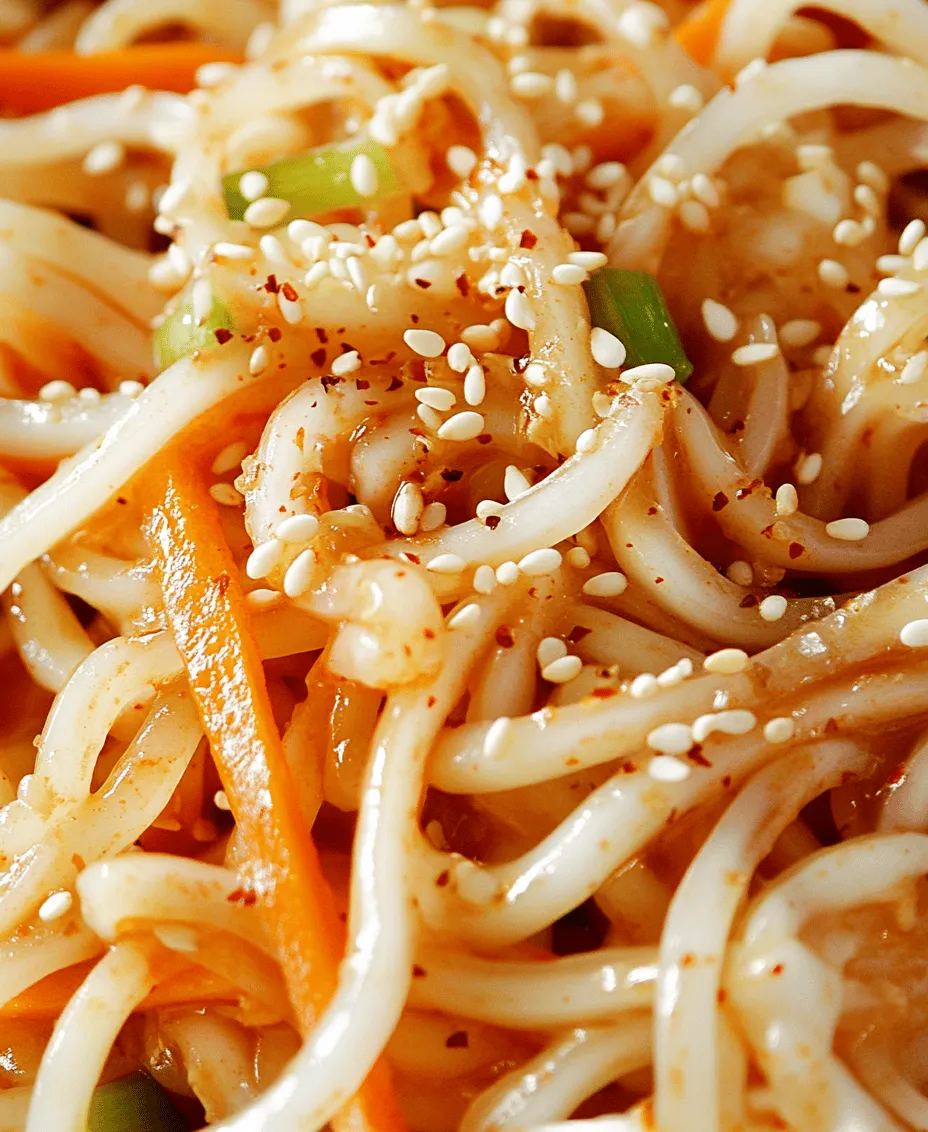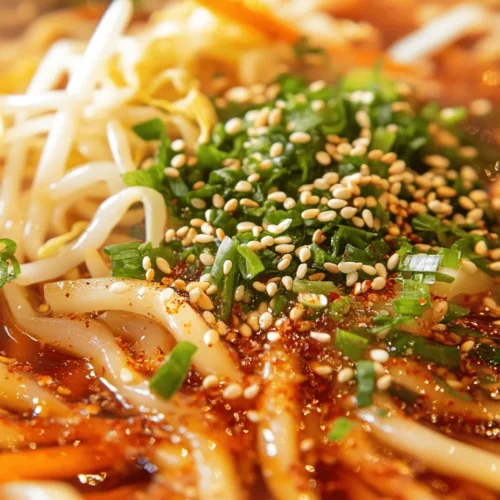In the fast-paced world we live in today, finding the perfect meal that is both quick to prepare and bursting with flavor can seem like a daunting task. Enter the 10-Minute Chili Oil Udon Noodles—a dish that not only satisfies your hunger but also piques your culinary curiosity. This recipe represents the epitome of convenience, allowing busy individuals and families to indulge in a delicious bowl of udon noodles infused with a spicy chili oil, all within the span of just ten minutes.
Udon noodles, known for their thick, chewy texture and adaptability, serve as the perfect canvas for an array of flavors. With the addition of homemade chili oil, you transform a simple dish into an unforgettable experience that tantalizes your taste buds. This article will guide you through the preparation and ingredients of this delightful meal, exploring the cultural significance of udon noodles and offering insights into variations and serving suggestions.
Understanding Udon Noodles: A Brief Overview
Exploring the Origins of Udon Noodles
Udon noodles have a rich history that dates back to ancient Japan, believed to have been introduced during the Heian period (794-1185). The exact origins are somewhat murky, with some theories suggesting that udon was derived from a type of Chinese noodle brought to Japan. Over the centuries, udon has evolved into a staple in Japanese cuisine, enjoyed in various forms across the country.
The unique characteristics of udon noodles lie in their thick, chewy texture, which is achieved through a simple combination of wheat flour, water, and salt. Unlike other noodle varieties, udon is often enjoyed in a warm broth, sautéed, or served cold with dipping sauces. Its versatility allows it to pair beautifully with an array of ingredients, making it a favorite in both traditional and modern dishes.
Nutritional Benefits of Udon Noodles
Many people may overlook the nutritional value of udon noodles, but they offer several benefits that contribute to a balanced diet. Primarily composed of carbohydrates, udon noodles serve as a great source of energy. A typical serving of udon provides around 200 calories, with a moderate amount of protein and minimal fat.
Additionally, udon noodles are often made with whole wheat flour, which can enhance their nutritional profile by adding fiber and essential nutrients. When prepared with fresh ingredients, such as vegetables, proteins, and healthy oils, you can create a well-rounded meal that satisfies both your taste buds and your nutritional needs.
Ingredients Breakdown: What You Need for Chili Oil Udon Noodles
Essential Ingredients for the Recipe
To create a delicious bowl of 10-Minute Chili Oil Udon Noodles, you will need the following essential ingredients:
1. Udon Noodles: The star of the show, udon noodles provide a chewy texture and are perfect for absorbing flavors. You can find fresh or frozen udon noodles at Asian grocery stores or in the international aisle of your supermarket.
2. Chili Oil: This is where the magic happens! Chili oil adds a spicy kick that elevates the entire dish. You can either purchase pre-made chili oil or make your own by infusing oil with dried chili flakes, garlic, and spices.
3. Soy Sauce: A key ingredient in many Asian dishes, soy sauce adds depth and umami flavor to the dish. Opt for low-sodium soy sauce to control the salt content.
4. Sesame Oil: A few drops of sesame oil enhance the nuttiness of the noodles and add a rich aroma.
5. Rice Vinegar: This ingredient brings a tangy brightness that balances the richness of the oil and soy sauce.
6. Garlic: Fresh minced garlic adds a fragrant kick that complements the chili oil beautifully.
When preparing your chili oil, it’s essential to adjust the amount according to your personal heat preferences. If you prefer a milder dish, start with a smaller quantity of chili oil and gradually add more to your taste.
Garnishes and Optional Additions
To elevate your 10-Minute Chili Oil Udon Noodles, consider adding garnishes and optional ingredients for a personalized touch. Here are some suggestions:
– Sesame Seeds: Toasted sesame seeds add a delightful crunch and nutty flavor, making them a perfect topping for this dish.
– Fresh Cilantro: Chopped cilantro brings a burst of freshness that contrasts beautifully with the spicy chili oil.
– Green Onions: Sliced green onions add a sharp bite and a vibrant splash of color to your noodles.
– Protein Options: To make the dish heartier, you can include proteins such as grilled chicken, shrimp, or tofu. Simply sauté your protein of choice and mix it in with the noodles.
– Vegetables: Feel free to toss in some quick-cooking vegetables like bok choy, bell peppers, or snap peas for added nutrition and color.
Step-by-Step Instructions: How to Make 10-Minute Chili Oil Udon Noodles
Preparing the Udon Noodles
To kick off your culinary adventure, the first step is to prepare the udon noodles. Here’s how to do it perfectly:
1. Boil Water: Fill a large pot with water and bring it to a rolling boil. The amount of water will depend on the quantity of udon noodles you are cooking, but aim for at least four cups.
2. Cook the Noodles: Once the water is boiling, add the udon noodles. Fresh udon noodles typically take about 2-3 minutes to cook, while frozen noodles may take a little longer—around 4-5 minutes. Stir occasionally to prevent sticking.
3. Check for Doneness: The noodles should be soft yet chewy. To ensure they are cooked perfectly, taste a strand before draining.
4. Drain and Rinse: Once cooked, drain the noodles in a colander and rinse them under cold running water. This step is crucial as it stops the cooking process and removes excess starch, preventing the noodles from becoming gummy.
Crafting the Flavorful Sauce
With your udon noodles ready, it’s time to craft the flavorful chili oil sauce that will bring your dish to life. Follow these steps for a delectable sauce:
1. Heat the Oil: In a small pan, heat a few tablespoons of oil over medium heat. This can be a neutral oil like vegetable oil or even the same oil used to make chili oil for an extra kick.
2. Infuse the Flavors: Add minced garlic to the pan and sauté until fragrant, about 30 seconds. Be careful not to burn the garlic, as it can turn bitter.
3. Combine Ingredients: Once your garlic is fragrant, remove the pan from the heat and add chili oil, soy sauce, sesame oil, and rice vinegar. Stir well to combine, ensuring that all the flavors meld beautifully.
4. Taste and Adjust: Before adding the sauce to the udon noodles, taste it and adjust the flavors to your liking. If you desire more heat, feel free to add additional chili oil or a pinch of red pepper flakes.
In just a few simple steps, you’ve created a vibrant, complex sauce that will enhance the udon noodles and create a truly memorable meal.
Stay tuned for the next part of the article, where we will delve deeper into serving suggestions, variations, and tips for achieving the best results with your 10-Minute Chili Oil Udon Noodles!

Tips for Adjusting Flavors According to Personal Preference
When cooking, the best results often come from adjusting flavors to suit your taste. With 10-Minute Chili Oil Udon Noodles, there are several ways to personalize this dish. Start by tasting the chili oil. If you prefer a milder flavor, mix in a bit of sesame oil to tone down the heat while adding a nutty aroma. Alternatively, if you enjoy a stronger kick, consider adding a splash of sriracha or a sprinkle of crushed red pepper flakes during cooking.
Another flavor booster is the addition of a splash of soy sauce or a dash of vinegar. Soy sauce enhances the umami profile, while vinegar can brighten the overall taste. Adjust these ingredients gradually, as they can significantly change the dish’s character. Remember, the key to a delicious meal is balance; so, taste as you go and modify according to your preferences.
Combining and Serving the Dish
Once all components of your 10-Minute Chili Oil Udon Noodles are ready, it’s time to combine them effectively. Begin by draining the cooked udon noodles and rinsing them briefly under cold water to stop the cooking process and remove excess starch. This step not only helps prevent the noodles from becoming gummy but also allows them to absorb the flavors more efficiently.
In a large mixing bowl, combine the udon noodles with the prepared chili oil, soy sauce, and any additional ingredients you’ve chosen to incorporate. Use tongs or chopsticks to gently toss the noodles, ensuring an even distribution of the sauce and spices. This method helps each strand of udon become coated in the savory and spicy mixture, enhancing the overall flavor.
For serving, choose deep, wide bowls that allow the noodles to be the centerpiece of the dish. Carefully twirl the noodles into nests and place them in the bowls. To elevate the presentation, garnish with fresh herbs like cilantro or green onions and add a sprinkle of sesame seeds or a drizzle of extra chili oil on top. This not only makes the dish visually appealing but also invites your guests to enjoy the layers of flavor awaiting them.
Flavor Variations: Customizing Your Udon Experience
Exploring Different Spice Levels
One of the best aspects of the 10-Minute Chili Oil Udon Noodles is the flexibility to adjust the spice levels according to your preference. If you enjoy a milder dish, consider using a garlic-infused oil or a less spicy chili oil. For a medium heat, regular chili oil works perfectly, while for those who love an intense kick, opt for chili oils infused with additional spices or even homemade versions that can pack a punch.
You can also experiment with the type of chili oil you use. For instance, Sichuan chili oil brings a unique, numbing heat thanks to Sichuan peppercorns. Alternatively, Thai chili oil often adds a sweetness that balances out the heat, creating a different flavor profile altogether. By selecting the right chili oil, you can transform the entire dish and cater it to fit your palate.
Incorporating Additional Ingredients
To create a heartier meal, consider adding proteins such as tofu, chicken, or shrimp to your udon noodles. For a vegetarian option, pan-fried tofu is an excellent choice, as it absorbs flavors beautifully and adds a satisfying texture. Simply cube the tofu, pan-fry until golden, and toss it with the noodles before serving.
If you prefer meat, thinly sliced chicken or shrimp can be cooked quickly in the same pan used for the noodles. Season them lightly with soy sauce and sesame oil before combining them with the noodles. This method ensures that the flavors meld together, giving you a rich and satisfying meal.
Vegetables are also a great way to enhance the nutritional value of your udon dish. Consider adding bell peppers, broccoli, or snap peas for a crunchy texture. Mushrooms, such as shiitake or enoki, not only add a savory depth but also increase the umami quality of the dish. Lightly sauté any desired vegetables before mixing them with the noodles for a colorful and healthy presentation.
Cultural Context: The Role of Udon in Japanese Cuisine
Udon in Traditional Japanese Dishes
Udon noodles have a long-standing place in Japanese cuisine, often celebrated for their versatility and comfort. Traditionally, udon is served in a simple broth, garnished with green onions and tempura, making it a staple dish, especially in colder months. Different regions in Japan have their own variations, such as the Sanuki udon from Kagawa Prefecture, known for its firm texture, or the kitsune udon, topped with sweetened fried tofu.
The beauty of udon lies in its adaptability; it can be served hot, cold, in soups, or stir-fried, each preparation showcasing the noodle’s ability to complement various flavors. This cultural significance adds a layer of appreciation when preparing your own version of udon noodles, reminding us of the rich culinary traditions that inspire modern recipes.
The Global Appeal of Udon
In recent years, udon noodles have gained popularity beyond Japan, becoming a favorite in international cuisine. Chefs and home cooks alike have embraced udon, incorporating it into fusion dishes that blend different culinary traditions. One popular trend is using udon in place of pasta in Italian dishes, creating a unique take on classic recipes like carbonara or stir-fried pasta dishes.
Moreover, udon has found its way into various Asian-inspired bowls, where it serves as a robust base for colorful vegetables and proteins, topped with flavorful sauces. This versatility has made udon a go-to ingredient in many kitchens, appealing to those seeking quick, fulfilling meals.
Conclusion: The Joy of Quick and Flavorful Meals
The 10-Minute Chili Oil Udon Noodles exemplify how easy it can be to prepare a quick, flavorful meal without compromising on taste. The beauty of this dish lies not only in its simplicity but also in its adaptability. By experimenting with different flavors, spice levels, and additional ingredients, you can create a personalized udon experience that suits your palate.
Cooking should be a joyful and creative endeavor, and this recipe encourages you to embrace that spirit. Whether you’re looking for a quick lunch or a satisfying dinner, these udon noodles can be your canvas for culinary exploration. So, gather your ingredients, unleash your creativity, and enjoy the delicious journey of making 10-Minute Chili Oil Udon Noodles. Quick meals do not have to be bland; instead, they can be an exciting addition to your culinary repertoire that brings warmth and satisfaction with every bite.



